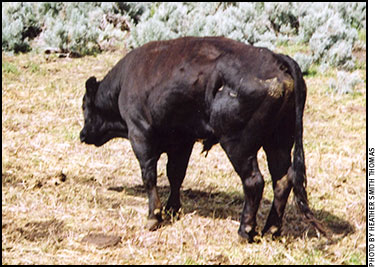Foot Rot in Cattle
Severe lameness, inflammation and a foul smell usually indicate foot rot is the culprit.
Foot rot is an infectious condition that causes swelling, heat and inflammation, resulting in severe lameness. Swelling and lameness usually appear suddenly — one day the animal is fine, and the next day, the foot may be so sore the animal won’t put weight on it.

Any little nick, scrape or puncture around the hoof, heel or between the toes may open the way for opportunistic invaders that cause foot rot.
Andrew Niehaus, associate professor at the Ohio State University Veterinary Hospital, says foot-rot-causing bacteria are generally present in the environment. Animals living in an unsanitary environment where there is a lot of manure are most at risk.
“We tend to see more cases in wet, muddy conditions. Feet are constantly wet, which makes the skin softer. It becomes easier for pathogens to penetrate the skin barrier,” he says.
Any little nick, scrape or puncture around the hoof, heel or between the toes may open the way for opportunistic invaders.
“The organisms that cause foot rot are anaerobic, which means they thrive without oxygen,” he says.
If the foot is in mud, there’s not much oxygen, and this makes the perfect habitat for those pathogens. If cattle are wading through mud or standing in a muddy feedlot, they are at higher risk.
“The two organisms implicated in foot rot are Dichlobacter nodosus and Fusobacterium necrophorum. They are somewhat symbiotic in that they may work together. One of them enters the break in the skin and then the other one comes along and helps perpetuate the infection,” says Niehaus.
These bacteria multiply and cause further death and destruction of tissue. This leads to more anaerobic conditions as the tissue dies, which facilitates the infection.
“The early stages of disease are often seen in the interdigital space between the toes. As it becomes worse, it may spread up the leg, with noticeable swelling,” Niehaus describes.
Inflammation and swelling of affected tissues are a hallmark of this disease. The swelling and lameness may be similar to that of an animal suffering from a fracture or snakebite.
It is important to have a diagnosis because several other conditions can look like foot rot.
“It could be a fracture, a joint infection due to progressive infection from an ulcer in the bottom of the foot or a puncture wound. There may be swelling around the area of the coronary band, and it may break out there and drain. Those are some of the differentials we should consider when we see a swollen foot and a very lame animal,” he explains.
When making a diagnosis it is important to look closely at the foot. Niehaus prefers putting the animal on the tilt table if it is brought to the hospital. On the farm or ranch, the animal should be in the chute and its foot lifted up with a rope. In a pasture setting, the animal should be roped and cast.
“With foot rot, the diagnosis is usually based on the fact there is a lot of pain in the interdigital space. It looks necrotic and has a characteristic foul smell. If you ‘floss’ between the toes with a piece of twine or towel, pulling it back and forth, it is very painful for the animal. Even just touching the affected area may elicit a painful reaction,” he says.
Niehaus says the best way to cure the infection is to get the animal out of wet, dirty conditions.
“We can hasten recovery with systemic antibiotics and local treatment, putting oxytetracycline on a gauze pad and wrapping it to hold it next to the affected area. There are several good antibiotics labeled for foot rot, so we usually give the animal a systemic antibiotic as well,” he says.
If you catch it early, the infection can usually be cleared up quickly. It may take longer if the animal was not seen in the beginning and treatment isn’t started until after it has been lame a while.
“As it spreads through the soft tissue, it may go into the joint as well. Then it becomes more difficult to treat,” he says.

Editor’s Note: Heather Smith Thomas is a freelance writer and a cattlewoman from Salmon, Idaho.






